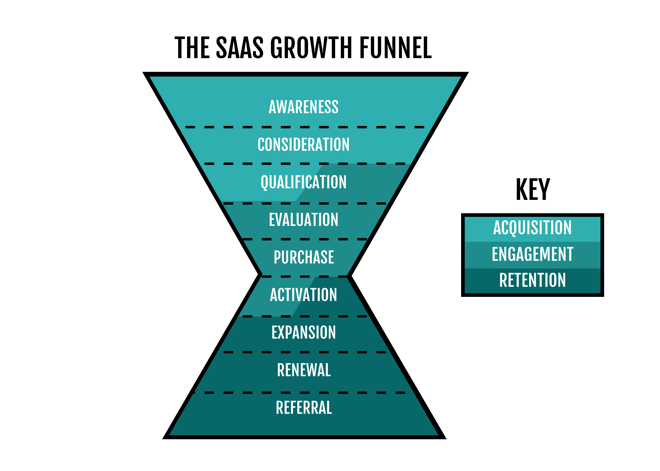The SaaS customer lifecycle covers the acquisition, engagement and retention of your customers. Depending on where they are in their lifecycle, customers need different things from your company to help them achieve their desired outcomes and move to the next stage in the cycle.
Today I’m breaking the SaaS customer lifecycle down into nine stages, and mapping out what your customers are doing at each stage of the cycle.

Acquisition Stages
During the acquisition stages of the customer lifecycle, customers are looking for a solution to a problem they’re experiencing. Education is vital at this point: you need to help your customers understand their problem, and help them understand how your SaaS tool will help them solve it.
Traditionally, companies aren’t great at this – they have a tendency to sell too hard, too soon, and put-off prospective customers with an overly enthusiastic sales pitch when they’re in ‘research mode’, rather than ‘buying mode’.
1) Awareness
At this super-early stage of the customer lifecycle, your customers are first realising they’ve got a problem, and are starting to learn more about it, and research options for solving it.
2) Consideration
By now, your customers will have a decent understanding of their problem, and will have identified several potential SaaS solutions that they’re considering.
3) Qualification
Your customers will narrow down their options to just a few solutions. They might start free trials, request a demo, or start a conversation with your sales team.
Engagement Stages
The engagement stages are key to the success of your SaaS company. It’s where your customers make their leap of faith, and start paying for your service. According to Intercom, 40-60% of users use a SaaS product once, and then never return.
You then need to provide real, tangible value to the user as quickly as possible, to convince them that it’s worth their investment. Getting that first session right is essential for keeping your customers coming back for more.
4) Evaluation
Your customers are now in the final stages of their decision-making. They’ll be asking your sales team very usage-specific, or company-specific questions about the capabilities of your solution, to assess whether or not your solution will meet their needs and solve their problem.
5) Purchase
This is it – the magic moment when they part with their credit card details and officially become paying customers.
6) Activation
Now they’ve paid for your service, your customers are starting to use it. They’ll work through any onboarding processes you have, and (hopefully) start to get value from using your solution.
Retention Stages
In these later stages of the customer lifecycle, your focus should be on customer success: providing continuing value to your customers, and providing excellent support and information to help your customers maximise the value they get from your service, to reduce or prevent churn.
It’s cheaper to retain existing customers than it is to acquire new ones, but many companies often overlook investing in customer success, focusing instead on lead generation and customer acquisition to fuel their business growth.
7) Expansion
By now, your customers will be regular users of your SaaS product, and be convinced of the value of your service. They may decide they need additional features or functionality available from higher-price packages, expanding from the initial package or service they signed up for.
8) Renewal
Your customers’ initial contracted use period has come to an end, and they decide to continue paying for, and using, your service.
9) Referral
Your customers are delighted with your service, and are so impressed with the value you deliver, that they’re recommending your service to colleagues, or others in their network.
How to Master the SaaS Customer Lifecycle
The customer lifecycle maps out how your customers engage with your company and your service. It's important that you understand and monitor the customer lifecycle in its entirity: it can be very easy to get drawn in to focusing all your efforts in optimising one stage of the lifecycle, when doing so won't help your customers achieve their desired outcomes more easily or quickly.
By tracking key metrics at each stage, you can identify any weaknesses that are limiting your customer acquisition, engagement or retention, so that you can make improvements where it matters most.
In order to track those metrics, appropriately engage customers at each stage, and continually optimise for revenue growth: you'll need the right software.
We've found the best software SaaS companies can use for the purpose is HubSpot, without contest. We've been using, working with and recommending it for over a decade, and you can get started for free.




